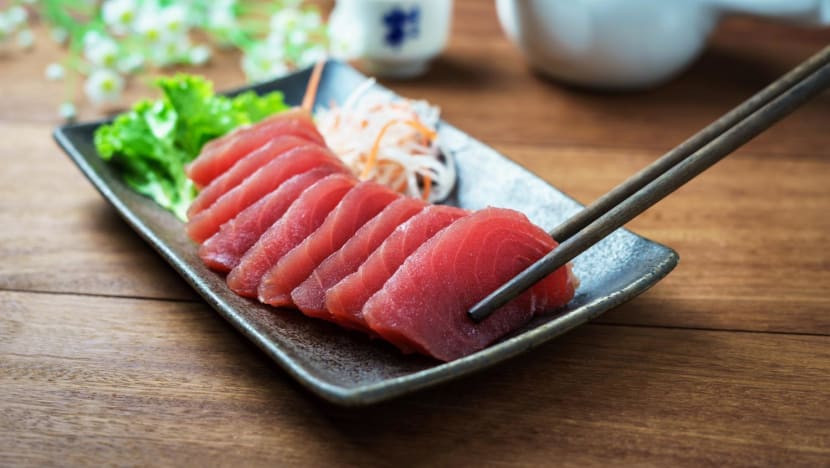How do food outlets and delivery providers ensure that raw fish is safe to consume?
How do they minimise the risks of consuming ready-to-eat raw food like sashimi and what checks are in place to maintain the quality?

A file photo showing tuna sashimi. (Photo: iStock)
SINGAPORE: Food establishments and delivery companies in Singapore said they adhere to stringent hygiene standards to ensure ready-to-eat raw food products like sashimi are safe for consumption.
The risks of eating raw seafood was highlighted after a couple found a parasitic worm in a rice bowl bought from a Don Don Donki outlet at 100AM mall earlier this month.
They then posted photos and videos of the fish on Facebook, saying it made them feel "so uncomfortable and nauseated".
"Never in our lives have we encountered parasitic worms in our food locally or overseas," she said.
The Singapore Food Agency said in response to the incident that customers who choose to eat ready-to-eat raw fish should be aware of the risks involved.
CNA takes a look at how outlets selling and handling such products minimise these risks, and ensure that they remain fresh and uncontaminated until they reach customers.
FREQUENT CHECKS, STRINGENT MEASURES AT OUTLETS
RE&S, which operates sushi chain Ichiban Sushi and Japanese market Kuri-ya, said raw food sold at its outlets are prepared both on-site and at a central kitchen.
Those from the central kitchen are delivered in refrigerated and freezer trucks with proper cold chain management to ensure quality is maintained.
“Upon receiving the goods at the outlet, staff will check the temperature before transferring items to the chiller immediately,” it said in response to queries from CNA.
Additionally, sashimi items sold at its outlets are subject to stringent temperature control, hygiene checks and handling procedures to ensure that they are safe for consumption.
“For example, we regularly monitor the temperature of our open display chillers to be maintained below 4 degrees Celsius,” it said.
Temperatures are checked at least twice a day, with staff also randomly conducting visual checks on the display items throughout the day.
“Routine bacterial tests are also conducted for sushi and sashimi products in accredited laboratories,” it added.
RE&S said raw fish product in open fridges have a shelf life of 12 hours and all unsold items are discarded.
Cold Storage operator Dairy Farm Group also said it adheres to stringent food safety and hygiene standards.
These comprise multiple checkpoints such as “robust quality checks, receiving checks, temperature checks and visual checks”.
“In addition, we have a strict supplier partner selection process to ensure that we are only working with suppliers that are able to comply with our high standards,” Dairy Farm Group said.
All team members and supplier partners are trained on these requirements, with strict compliance checks in place.
“Supplier partners who operate in our stores such as fish and sushi counters conduct regular visual checks during food preparation and when food items are displayed in-store,” it said.
This helps to ensure the quality and safety of the products, it added.
RE&S said that there has been "occasional feedback" on food quality, and in such instances, it either replaces the items or refunds the customers.
"At the same time, we will conduct internal investigation to trace the cause of the quality issue,” RE&S added.
ENSURING QUALITY FOR DELIVERIES
For delivery orders, RE&S said it works with delivery partners such as GrabFood and Deliveroo.
“All our delivery sushi and sashimi products also bear ‘consume within 2 hours’ stickers and all sashimi products are accompanied by ice packs,” it added.
Describing food safety as being crucial to its business, delivery platform foodpanda said it works with its merchant, rider partners and the industry to maintain safety standards.
Practices and initiatives include insulating food delivery bags to ensure that food items either stay hot or cold items remain cold, as well as mandating that all completed deliveries are accompanied with a visual proof of delivery to verify that food is left in hygienic locations.
“As delivery partners do not repack the food to avoid inadvertently contaminating the food, we encourage merchant partners to pack cold and hot food in separate bags,” it said.
Frozen items, including from its online grocery store pandamart, are also packed in thermal bags with frozen gel packs to limit drastic changes in temperature while it is out for delivery.
“Food products such as fresh produce, raw meat and seafood typically require more attentive handling in order to ensure their freshness,” it said.
“Fresh produce and refrigerated food are also stored properly in chillers before they are packed and delivered.”
It added that customers who opt for contactless delivery are informed via in-app prompts when their food is picked up and when the delivery rider is nearby so that they can promptly collect it.
“This ensures that the food delivered is received and consumed in a timely manner,” foodpanda said.
















